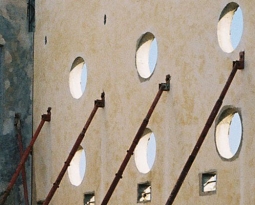Whether in times of economic up- or down-turn; cost effective design and longevity of a build are key determinants in budgetary and tender processes as well as the choice of building material required. Tilt-up construction proves to be a very economical alternative to traditional building materials and engineering without losing aesthetic appeal and overall quality. To this end “Gary Theodosiou, engineer and lecturer at The Concrete Institute, says tilt-up construction is often overlooked in the design of structures but can be one of the most cost-effective building techniques [available].”1
While hardly a new process in construction, tilt-up has really made its mark in the 20th century, largely attributed to the development of concrete consistently being reinforced with rebar, the availability of read-mix concrete, and the development of the mobile crane. Used extensively in the post-War booming Unites States to build warehouse styled factories, tilt-up has gained in popularity, refinement and creativity. In 1986 the Tilt-Up Concrete Association (TCA) was created in the Unites States to establish processes and standards to ensured continued growth in quality and acceptance for this method of construction.
Tilt-up has been used in buildings as large as 1.7 million square feet, with individual panels reaching as high as 91 feet and weighing 150 tons. In the United States, as reported by the TCA, 15% of all industrial buildings were created using tilt-up construction. Given its success in the United States, builders in Australia, Mexico, Canada and more recently in South Africa are increasingly using this method.
Our Tilt-Up projects developed out of a project for LG Electronics in 2003. Having noted the success of the tilt-up method internationally, we, in association with Tilt-Up Technologies Pty (Ltd) evaluated the sustainability and viability of the construction method under local conditions and built the 6 000m2 warehouse. The success of the project was irrefutable upon completion of the works – having delivered within budget and with a reduction in construction time of 30% should conventional methods been used.
The tilt-up method replaces conventional brick-laying and form cast concrete with fit to purpose panels. These panels are designed and engineered to be poured on site in their final shape and exterior finish. When cured, the panels are lifted by crane and placed in a sequenced pattern to create the building’s structure.
A successful tilt-up project begins long before the first batch of concrete is poured, with an extensive planning process and successive core stages until completion. The five core stages are site evaluation; engineering; panel forming; panel lifting and placement and panel finishing. The many benefits include savings in construction costs, a fast construction schedule, fast track delivery, faster occupation, customised aesthetics, increased security, reduced operating costs, fire and construction safety, durability, ease of maintenance, easier repairs and expansion posibilities and reduced insurance premiums.
Our projects include:
- Repo Wild, a 1 200m2 industrial complex comprising mini-factories in Ballito Industrial Park (2006)
- Delaval, 3 000m2 warehouse space in Westmead, Durban (2007)
- Freddy Hirsch, 4 000m2 warehouse space also in Westmead, Durban (2007)
- Pinnacle Park, a 1 600m2 office complex in Ballito Industrial Park (2007)
- McCall’s Patterns Warehouse, 1 200m2 including the warehouse space and front offices in Ballito Industrial Park (2008)
- Meadowbrook Park, a 1 800m2 mini-factory development in Ballito (2008)
- Esikhawini Plaza, a 14 000m2 retail shopping centre in Esikhawini, Richard’s Bay, Northern KwaZulu-Natal (2010)
- The Quarter, a 3 000m2 boutique shopping centre in Ballito (2011)
- Umzimkhulu Business Centre, a 16 000m2 retail shopping centre in Umzimkhulu, Southern KwaZulu-Natal (2012)
- Chairman’s Park, a (10 000m2) storage unit development in Shaka’s Rock, Ballito (2014)
1 | “Tilt-Up Construction for Cost-Effective Aesthetics and Durability”, Creamer Media Staff Reporter; CREAMER MEDIA’S – ENGINEERING NEWS; 22 October 2013; www.engineeringnews.co.za



